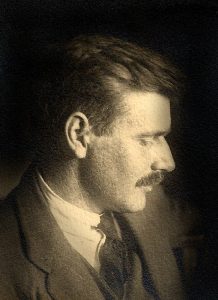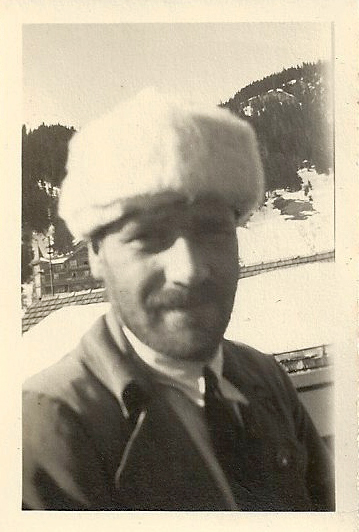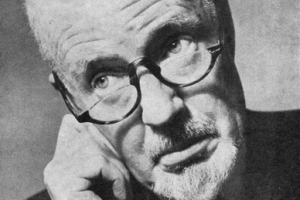Physician and author, tireless advocate of apomorphine. He endeavoured to make it widely available and made it famous enough to last.

Dr John Yerbury Dent was one of the few doctors to be so completely identified with a treatment that it was named after him; the ‘Dent method’ (1), a short and intense course of treatment for alcoholics. An avuncular and no-nonsense man, he inspired devotion in both his patients and nurses. The same independence of thought and interest in his patients which led him to develop the treatment, however, were also the eventual cause of its slide into obscurity.
Dent showed signs of an acute yet rebellious intellect at an early age, a quality which stayed with him his entire life. He began his medical studies in 1905. After a week at Cambridge University, which sat ill with his Quaker background, he came down and enrolled at King’s College Medical School, following in the footsteps of his father and uncle. He was careful only to attend 4 days a week, serially skipping lectures to go on trips to the countryside with his uncle to study geology and go mountaineering. His disrespect for authority manifested in a campaign of provocative letters to the Principal (an exasperated Dr Headlam), for which he was eventually expelled, much to his and his father’s delight. As Dent was popular with his lecturers, they invited him to continue to attend, and so the expulsion was barely an impediment to his continued education, but delayed his qualification as a doctor.

Dent’s willingness to treat those in the direst conditions led him to contract tuberculosis from slumdwellers around Holborn in 1913. (2) A year spent recovering in a sanatorium gave him time to read widely and refine thoughts on the purpose of authority. With the outbreak of the First World War the demand for doctors saw the newly qualified Dent taking on responsibilities far beyond his training at the new Kings College Hospital in Denmark Hill. Determined to do ‘real work’ treating patients he evaded the bi-weekly drills which all male hospital staff were required to perform by so angering the drill sergeant that the latter refused to examine Dent’s fitness, at which point Dent promptly examined himself and declared himself unfit due to a ‘cavity in the lung’. (3)
But this was not mere cheekiness; his Quaker background left him with both a disrespect for conventional authority and a profound concern for his patients. In 1917 Dent was posted to the Norfolk and Norwich Hospital where he treated the war- wounded. He dispensed with the rule which forced injured soldiers to stand and salute officers before entering the hospital for treatment. He removed the rank insignia from soldiers’ beds, as these had been used to give different levels of treatment for different ranks. (4)

Dent first encountered apomorphine, the drug that would become the lynchpin of his treatment of addicts, while working as a junior doctor at St Pancras Workhouse Infirmary just after the first word war. There were destitute people in the area who, having drunk too much, would need emergency treatment to clear alcohol from their system. There were two accepted ways to do this; pumping out the patient’s stomach, a procedure that left patients feeling much the worse for wear, and apomorphine. While the vigorous vomiting caused by apomorphine wasn’t pleasant, Dent observed that his patients felt in “fine fettle” the next morning. (5)
Intriguingly, he also noticed that the patient was left with a ‘distaste’ for alcohol. This incidental observation planted the seed of an idea that would germinate some time later.
In 1924 Dent became a general practitioner at his father’s practice in Kensington, an affluent district of London. His father referred to him many of his more challenging patients, mainly alcoholics. Dent came to rely increasingly on apomorphine, not just as a method to empty the stomachs of his patients, but to treat what he saw as the underlying insecurities of his patients. The drug, he wrote, had ‘a remarkably soothing effect (for) agoraphobia, hysteria, melancholia, schizophrenia, delirium tremens and alcoholism.’ (6)

This focus on the wellbeing of his patients, as well as his genial manner, established his reputation as a man who could successfully treat alcoholics whom others had failed. As his income rose, he moved from a single consulting room to renting two floors in a nursing home at 99 Cromwell Road, where he developed an intense seven-day treatment plan for alcoholics. Always supervised by nurses and following a strict regime, the patient was given a continuous course of apomorphine injections every two to four hours for the first two days and his or her preferred alcoholic drink. Only when the patient had overcome their urge to drink alcohol was the patient offered a non-alcoholic drink and some food. The regime of repeated apomorphine injections continued for a further two days to ensure no alcohol remained in the patient’s system. This whole process took some 5 weeks less than conventional sanatorium treatment at the time. (7)
But why alcohol and apomorphine at the same time? The answer lay in his encountering an unfortunate idea at the wrong time; that of the “conditioned reflex”. In the late 1920s and early 1930s researchers, mainly Russian, were publishing a series of papers discussing the application of Pavlovian principles of psychology to humans. (8) This meant attempting to associate particular actions or objects with unpleasant feelings in order to discourage the person from pursuing them; classic ‘aversion therapy’.
Dent, who had been attempting to discover why apomorphine had its effects on his patients, found these papers and seized upon them as a rationale for his treatment. This was a mistake that would haunt him and the reputation of his treatment for the rest of his career. In the short run, however, it was a useful way to legitimise his approach; in 1934 his paper ‘Apomorphine in the Treatment of Anxiety States with Especial Reference to Alcoholism’ was published in the Journal of the Society for the Study of Inebriety.* (9)
It would take some 15 years or so for Dent’s ideas to evolve to the point where he was willing to abandon the idea of aversion, partly because of his success in treating patients who had not vomited at all. In the meantime, he published ‘The Reactions of The Human Machine’ (10) and ‘Anxiety And Its Treatment’ (11), two works in which he discussed both what he saw as the addict’s physiological problems – imbalances of hormones and blood composition – and the psychological problems – most notably anxiety. He took an exceptionally progressive approach, discarding the moralising of the temperance movement to address what he saw as the disorders underlying alcoholism. And, within this framework, apomorphine addressed both elements of the disorder; helping addicts physically, calming them down and eliminating their craving.

He increasingly involved himself with the Society for the Study of Inebriety, becoming editor of its journal in 1941. He used this position to advocate better treatment for addicts and spread what he saw as the good news about apomorphine in his many editorial pieces, which was becoming strongly associated with him.
It was shortly after this that Dent finally fully committed to his new understanding of how the treatment worked:
I have been forced to the conclusion that apomorphine has some further action that the production of vomit. …
I have now given this treatment to over two hundred and fifty alcoholic patients and about 3% of these have produced no vomiting at all. Some others did not vomit the spirit given to them during the first stage (of the treatment)…. but vomited their tea during the second stage, and I thought, ‘Here I am producing an aversion for tea.’ Yet these people lost their craving for alcohol, developed no aversion to tea, and did as well as the others. If the main object were to produce a conditioned aversion to alcohol, the risk would not be taken of giving apomorphine during the second stage after the patient has been cut off his alcohol. (12)
Dent reported a 60-70% rate of full abstinence in his patients 1 year after treatment, with only a 10% rate of what he described as ‘complete failures’ (13). With knowledge of his method spreading and his editorial control over the main journal of alcohol researchers in the UK, renamed the ‘Journal of Addiction’ in 1946, everything seemed to be going very well.
Dent’s views were, in many ways, ahead of their time. He quickly recognised the dangers posed by barbiturates and was profoundly worried by the possibility of the UK adopting a US-style prohibition approach to heroin. Although his practice was operated mainly from a private clinic he was interested in making the apomorphine treatment available to all who needed it. His willingness to experiment to achieve a version of the treatment that could be administered quickly at home resulted in ridicule when it was revealed he had tried crushed apomorphine tablets inserted into the nose (apomorphine can be absorbed through the membranes of the nose), but it was a demonstration of his desire to help as many people as possible. (14)

Dent was beginning to assemble a rigorous evidence base for apomorphine treatment. The Cantonal Hospital in Switzerland under Dr Harry Feldmann, undertook a study of his method on 150 alcoholics and found it to be highly effective, spreading the idea in Northern Europe. (15) Dent procured funding for research at the Burden Institute on how apomorphine affected the physiology of rats. (16) Apomorphine was even listed as an approved treatment for alcoholism in the first report by the Alcoholism subcommittee for the nascent World Health Organisation. (17) Despite Dent’s unconventional roots, he was undertaking the conventional scientific and medical work to make apomorphine an accepted treatment.
Then came Antabuse. Developed in Denmark in 1947, the new (patentable) drug swept across the addiction world. It was cheap, seemingly effective and had a reassuringly punitive aspect – if you drank while under its effects, you would feel violently ill. It even chimed well with the idea of the conditioned reflex – drink, feel bad – classic aversion therapy. And, even better for doctors, it neither required an expensive seven-day in-patient procedure nor caused vomiting. Despite Dent’s attempts to promote apomorphine, Antabuse rapidly became the drug of choice. (18)
This came to a head with the arrival of the newly-founded National Health Service; Dent campaigned as hard as he could for the NHS to use apomorphine, but Antabuse was preferred. Britain’s laws which banned a doctor from advertising, which included using their name in the media, prevented him from making his treatment better known, and his repeated use of the Journal to spread the word began to irritate other British experts in the area. His attempts to get better training for junior doctors in the treatment of addiction were blocked. Dent respected the anonymity of his patients – many were the great and the good in the establishment. However, he was disappointed that they didn’t use their influence to support the cause for better provision. Discussing one’s own medical problems remained socially unacceptable amongst the upper classes, especially when speaking of the treatment involved admitting that they were an alcoholic.
Something good did come out of the whole Antabuse situation for Dent though; a friendship with the doctor who had conduct the clinical study on Antabuse to begin with, Oluf Martensen-Larsen. They corresponded, and Dent convinced him that apomorphine was more than merely an aversive drug. (19) After becoming disillusioned with Antabuse over the decade after its discovery – Martensen-Larsen returned to apomorphine and fathered a surge of interest in Scandinavia in the 1970s. This, however was too late for Dent.
Dent died in 1962, aged 73. By the end he had become a spent force, viewed as eccentric and old-fashioned by the ascendant guard of psychiatrists who were framing the direction addiction services were going to take. A few private GPs continued to use apomorphine to treat addiction, but the treatment had petered out completely in the UK by the early 1970s. By the 1980s he, and his method, had been largely forgotten outside Scandinavia.
Dent was the possessor of a legendarily good bedside manner. He inspired great devotion in his patients, several of whom went on to publish books discussing Dent and his method positively, among them the publisher Alan Maclean (20) and the composer Ursula Lutyens (21). Most important of all was his treatment of the American author William Burroughs in 1956, whose writings inspired later addicts to seek out the Dent method to treat addiction, from their own doctors. (22)
Before Dent, few people knew that apomorphine could be used to treat alcoholism, and fewer still had attempted to allay craving with it. By the time of his death he had established that doses of apomorphine by itself reduced anxiety and craving in alcoholics over both the short and longer term, with no need to make the patient vomit. His non-aversive method was the basis for much of the work done on apomorphine and alcoholism in the 1970s, some prompted by patients who had read works by Burroughs.
It is fitting that, stymied by the medical establishment with whom he had never got on, Dent’s method would find its justification in the writings of brave former addicts whom it had helped.
*Now ‘Addiction’.

References
1. Revilliod, H. The Third Kelynack Memorial Lecture. Some Aspects of The Problem of Alcoholism in Switzerland. The British Journal of Addiction, Vol 41, No 1. 1950.
2. Dent, J.Y. Draft 1, Memoirs. ‘1 Kings’, Dent family archive.
3. Dent, J.Y., Draft 1, Memoirs. ‘2 Kings’, Dent family archive
4. Dent, J.Y. Draft 1 ‘2 Lamentations’, Dent family archive
5. Dent, J.Y. Autobiographical notes, Chronicles, p.2. Dent family archive
6. Dent, J. Y. 1934. Apomorphine in the treatment of Anxiety States, with Especial Reference to Alcoholism. The British Journal of Inebriety. Vol.32. No.2.
7. Dent, A. 2010. Anecdotal reminiscence of Dent’s practice.
8. Choudhury, S. Slaby, J. Condition and Suggest: Narcology’s Therapies. Critical Neuroscience. A Handbook of the Social and Cultural Contexts if Neuroscience. John Wiley & Sons 2011
9. Dent, J. Y. 1934. Apomorphine in the treatment of Anxiety States, with Especial Reference to Alcoholism. The British Journal of Inebriety. Vol.32. No.2.
10. Dent, J.Y. The Reactions of The Human Machine, V. Gollancz, Ltd,1937.
11. Dent, J.Y. Anxiety and Its Treatment, John Murray, 1941.
12. Dent, J.Y. Apomorphine Treatment of Addiction. Some Recent Developments. The British Journal of Addiction. Vol 46. No 1. January 1941.
13. Ibid. (12).
14. Dent, J.Y. Self-Treatment of Anxiety and Craving, By Apomorphine, Through the Nose. The British Journal of Inebriety, Vol 41. No 2. 1944.
15. Morsier, G. Feldmann, H. The Biological Treatment of Chronic Alcoholism by Apomorphine. Study of 150 Cases. The British Journal of Addiction. Vol 42, No 2. 1950.
16. Ibid. (12)
17. Word Health Organisation Technical Report Series. No.42. Expert Committee On Mental Health, Report on the First Session of the Alcoholism Subcommittee. Geneva, 11 -16 December 1950. (5). Means of Treatment. Pages 13/14
18. Personal communication, Hore. B.D, (Manchester conference organizer,1974) with Rubinstein A. 19.04.2017.
19. Martensen Larsen, O. private correspondence with Dent, A. 18.10.90. Dent family archive.
20. Maclean, Alan. No I tell a Lie, It Was the Tuesday. Kyle Cathie Limited, 1997.
21. Lutyens, Ursula. A Goldfish Bowl, Littlehampton Book Service Ltd, 1972.
22. Schlatter, E.K.E. Treatment of alcoholics with apomorphine using Dent’s Method; A Preliminary Study. Quebec Psychopharmacological Association 08.02.1966.




